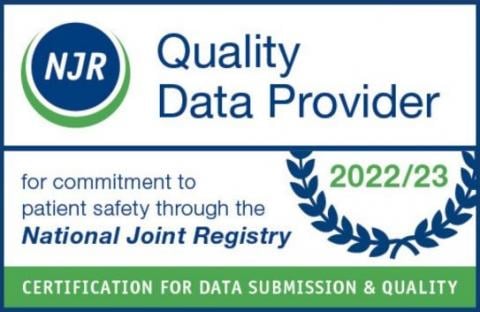
In the light of Fibroid Awareness Month and as part of our annual Women’s Health Campaign, we sought advice from Miss Silvia Carta, our experienced and trusted Gynaecology Consultant at New Victoria Hospital. We explored the topic of painful and heavy periods, the available diagnostics to establish their cause which, in nearly a third of cases, is uterine fibroids, and hysteroscopic tissue removal or hysteroscopic morcellation as a potential treatment option.
The National Heavy Menstrual Bleeding Audit by the Royal College of Obstetricians and Gynaecologists reported that 1 in 4 UK women of reproductive age have suffered from heavy menstrual bleeding (HMB). However, nearly one third had never sought medical help for menstrual disorders.
Another recent survey showed that the effects of HMB extend beyond physical symptoms, with 74% of the interviewed women feeling anxious, 73% nauseous, 69% depressed, and 49% anaemic. Sadly, two-thirds were unaware that HMB is a treatable medical condition, and half had never discussed it with their GP. Furthermore, over two thirds of women surveyed by the CIPD said they had negative experience at work due to their menstruation symptoms, with one in five having had to take sick leave.
While some period pain is normal and is not caused by an underlying condition, referred to as primary dysmenorrhoea by the doctors, severe pain and bleeding that is stopping you from going to work or school or from other daily activities is not normal and should be evaluated by a Gynaecologist. Period pain that is caused by an underlying health condition is called secondary dysmenorrhea.
Severe pain, heavy bleeding – menorrhagia, and irregular cycles are common symptoms of such gynaecological conditions as endometriosis, adenomyosis, fibroids [create an anchor link to the video intro about fibroids], polycystic ovary syndrome, and others, which require treatment and support. Each of these conditions has unique characteristics and symptoms, but sometimes they can be mistaken for one another due to overlapping symptoms like heavy bleeding and strong menstrual cramps.
To determine the cause, detect or exclude a particular condition, a combination of diagnostic tests and procedures can be used, so that the appropriate treatment can be determined.
There are several diagnostic tests available to identify the cause of gynaecological symptoms. Each investigation can be tailored and adapted to the woman’s needs and wishes, provided there is good understanding of the diagnostic value and how invasive and accurate the test is. Most of the times, the patients can gain significant insights and feel much more supported from having the initial consultation with guidance regarding appropriate options and tools to make an informed decision, without having to necessarily proceed to treatment at the time.
Diagnostic tests and procedures
- Pelvic examination: A thorough pelvic exam can help detect any abnormalities in the reproductive organs, especially if the growths are enlarged.
- Blood tests: Laboratory blood screenings can detect iron deficiency, thyroid disorders, or other abnormalities affecting blood clotting.
- Ultrasound: This imaging test uses sound waves to create pictures of the inside of the pelvis and can identify fibroids, ovarian cysts, and other structural abnormalities.
- Magnetic Resonance Imaging: An MRI can be used at later stages of diagnosis to characterise and identify the exact anatomical location of an adenomyoma, uterine fibroids, sites of deep endometriosis, and growths on the pituitary gland.
- Laparoscopy: A surgical procedure where a camera is inserted into the pelvis through a small incision. It is performed to view and access the exterior of the uterus, ovaries, fallopian tubes and other structures within the pelvis and is considered the gold standard for diagnosing endometriosis.
- Hysteroscopy: A procedure that involves inserting a small camera into the uterus through the cervix to look for abnormalities such as fibroids or polyps. It is performed to view the internal cavity of the uterus, identify abnormalities and perform certain corrective procedures. It is usually recommended to identify the cause of infertility, miscarriage, and abnormal uterine bleeding.
- Myomectomy: The surgical removal of uterine fibroids. Depending on indications, it can be done laparoscopically in a keyhole surgery, in an open surgery, or vaginally.
- Hysteroscopic morcellation: This is a procedure to remove fibroids, polyps and other intrauterine tissue by cutting them into smaller pieces using a device called a morcellator. Endometrial polyps are one of the most common intrauterine lesions associated with abnormal bleeding symptoms, while leiomyomas or uterine fibroids are the most common gynaecologic non-cancerous tumour with nearly a third being the cause behind HMB.
Hysteroscopic tissue removal at New Victoria Hospital
Hysteroscopic morcellation or tissue retrieval using MyoSure® system is a quick and minimally invasive method for removing polyps during polypectomy, fibroids during myomectomy, and other tissue on the inside of the womb for targeted biopsies and to treat heavy menstrual bleeding or abnormal bleeding. It is also useful in the investigations of postmenopausal bleeding and for removal of retained products of conception (RPOC) such as foetal or placental tissue.
This procedure allows to eliminate the unwanted uterine tissue without having to remove or even cut the uterus. In some cases, it can be an alternative to hysterectomy, which removes the uterus.
Why choose tissue retrieval with MyoSure®?
MyoSure® is the leading device for removing fibroids, polyps, and other intrauterine tissue while preserving the uterine form and function. It ensures that no affected tissue is left behind to minimise risks of spreading undetected cancer cells. The rate of complications is estimated to be very low. It uses local anaesthetic, avoiding the risks associated with general anaesthesia and the trauma of major surgery.
This procedure does not scar and preserves uterine form and function. The MyoSure® procedure leaves your womb intact, so it is an ideal treatment option if you want to preserve your chances for having children in the future.
What are the benefits of hysteroscopic treatment with MyoSure® in comparison to conventional methods?
Research shows that contemporary hysteroscopic tissue removal systems, like MyoSure, provide significant benefits by effectively removing pathological tissue and reducing surgery duration. These advantages make the procedure more available, decrease the risk of complications, and enhance reproductive results, including the likelihood of pregnancy.
Benefits include:
- Targeted and more accurate removal of the pathological tissue.
- Higher quality and integrity of biopsy samples compared to blind dilation and curettage procedures.
- Possibility to carry out the retrieval of larger intrauterine lesions in outpatient setting with local anaesthetic avoiding general anaesthetic in selected cases.
- Improved outcomes with reduced risks of reoccurrence, persistent symptoms, the need for follow-up visits and procedures, or long-term serious abnormalities.
Who is and is not suitable to receive MyoSure® procedure?
Women with infertility associated with unwanted tissue in the womb or with heavy or long-lasting periods caused by fibroids or polyps may be candidates for the MyoSure® procedure.
Your doctor will determine whether this treatment is suitable for you, after excluding other serious conditions that could cause abnormal bleeding from the uterus.
This procedure will not be suitable if you are pregnant, have pelvic infections, cervical malignancies, or a history of uterine or endometrial cancer. If you have fibroids within your uterine wall, they cannot be removed by the MyoSure procedure.
What to expect during the procedure?
Local anaesthetic will be applied to and around the cervix. Your doctor will insert the MyoSure hysteroscope with a camera through your vagina, allowing them to see inside your uterus to locate the abnormal tissue. Once it is located, a tissue removal tool will be inserted through the hysteroscope to remove the tissue causing your abnormal bleeding. The whole procedure takes from 10 to 30 minutes, and you will be able to watch it on a small screen if you wish to do so.
What to expect after the procedure?
After the procedure, you will be accompanied to a recovery area and offered a drink and further pain relief if needed. The procedure is done in the Outpatient department, so you will be able to go home on the same day after a brief rest. You should be able to resume your normal activities within 2 days. Some women may experience cramping, light bleeding or spotting for up to 2 weeks after the procedure. During this time, it is recommended that you avoid sexual intercourse and swimming, it is recommended to shower instead of taking baths and to use sanitary pads instead of tampons.
‘Breaking the Silence’ on Fibroids
During our Women’s Health campaign, we partnered with JFPR Consulting on the health panel discussion series ‘Breaking the Silence’ to cover topics such as Endometriosis, Menopause and the Pelvic Floor, and Uterine Fibroids.
You can watch the latest informative health discussion with our esteemed Gynaecology Consultant Miss Silvia Carta and an award-winning fibroids advocate Dawn Heels below and on our YouTube and Vimeo channels. This Uterine Fibroids episode seeks to uncover the options available to patients at each stage of their journey to health and what more can be done to safeguard women who are prone to this condition.
Heavy and painful periods are common issues that many women experience, but they are not something you have to endure in silence. Understanding the underlying causes and seeking the appropriate diagnostic tests can lead to effective treatment and significantly improve your quality of life.
At New Victoria Hospital, we strive to provide a relaxed environment where every woman feels safe and comfortable to discuss her concerns with our leading women’s healthcare specialists.
If you would like to receive more information on our Private Gynaecology Services at New Victoria Hospital or to make an appointment, please call our Outpatient Department on 020 8949 9020 or fill in our online form.













